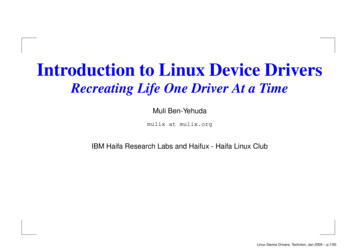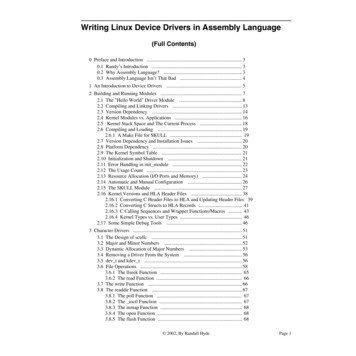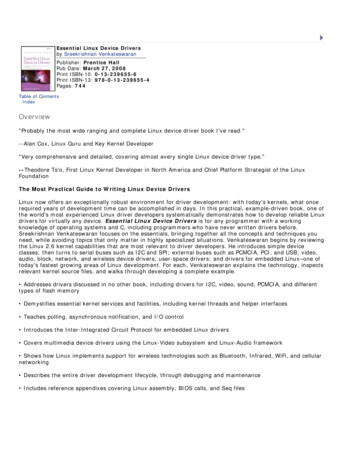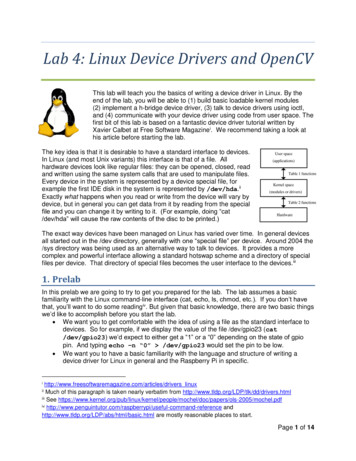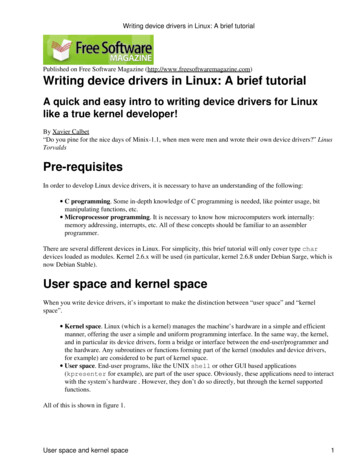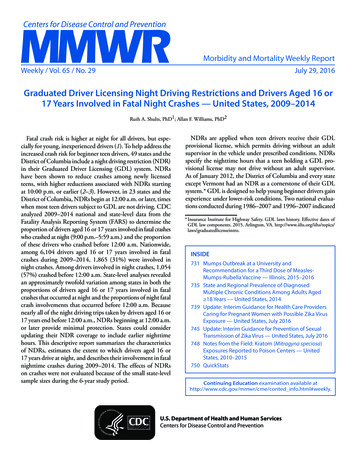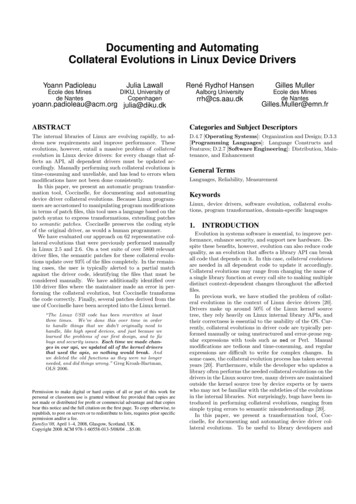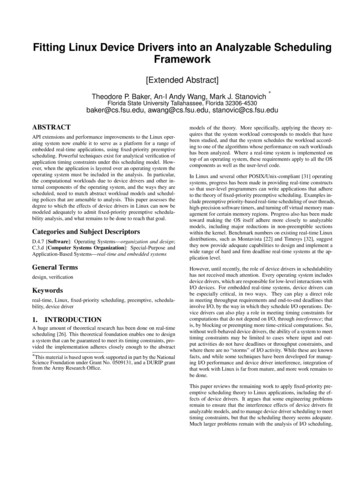
Transcription
Fitting Linux Device Drivers into an Analyzable SchedulingFramework[Extended Abstract]Theodore P. Baker, An-I Andy Wang, Mark J. Stanovich Florida State University Tallahassee, Florida 32306-4530baker@cs.fsu.edu, awang@cs.fsu.edu, stanovic@cs.fsu.eduABSTRACTAPI extensions and performance improvements to the Linux operating system now enable it to serve as a platform for a range ofembedded real-time applications, using fixed-priority preemptivescheduling. Powerful techniques exist for analytical verification ofapplication timing constraints under this scheduling model. However, when the application is layered over an operating system theoperating system must be included in the analysis. In particular,the computational workloads due to device drivers and other internal components of the operating system, and the ways they arescheduled, need to match abstract workload models and scheduling polices that are amenable to analysis. This paper assesses thedegree to which the effects of device drivers in Linux can now bemodeled adequately to admit fixed-priority preemptive schedulability analysis, and what remains to be done to reach that goal.Categories and Subject DescriptorsD.4.7 [Software]: Operating Systems—organization and design;C.3.d [Computer Systems Organization]: Special-Purpose andApplication-Based Systems—real-time and embedded systemsGeneral Termsdesign, verificationKeywordsreal-time, Linux, fixed-priority scheduling, preemptive, schedulability, device driver1.INTRODUCTIONA huge amount of theoretical research has been done on real-timescheduling [26]. This theoretical foundation enables one to designa system that can be guaranteed to meet its timing constraints, provided the implementation adheres closely enough to the abstract This material is based upon work supported in part by the NationalScience Foundation under Grant No. 0509131, and a DURIP grantfrom the Army Research Office.models of the theory. More specifically, applying the theory requires that the system workload corresponds to models that havebeen studied, and that the system schedules the workload according to one of the algorithms whose performance on such workloadshas been analyzed. Where a real-time system is implemented ontop of an operating system, these requirements apply to all the OScomponents as well as the user-level code.In Linux and several other POSIX/Unix-compliant [31] operatingsystems, progress has been made in providing real-time constructsso that user-level programmers can write applications that adhereto the theory of fixed-priority preemptive scheduling. Examples include preemptive priority-based real-time scheduling of user threads,high-precision software timers, and turning off virtual memory management for certain memory regions. Progress also has been madetoward making the OS itself adhere more closely to analyzablemodels, including major reductions in non-preemptible sectionswithin the kernel. Benchmark numbers on existing real-time Linuxdistributions, such as Montavista [22] and Timesys [32], suggestthey now provide adequate capabilities to design and implement awide range of hard and firm deadline real-time systems at the application level.However, until recently, the role of device drivers in schedulabilityhas not received much attention. Every operating system includesdevice drivers, which are responsible for low-level interactions withI/O devices. For embedded real-time systems, device drivers canbe especially critical, in two ways. They can play a direct rolein meeting throughput requirements and end-to-end deadlines thatinvolve I/O, by the way in which they schedule I/O operations. Device drivers can also play a role in meeting timing constraints forcomputations that do not depend on I/O, through interference; thatis, by blocking or preempting more time-critical computations. So,without well-behaved device drivers, the ability of a system to meettiming constraints may be limited to cases where input and output activities do not have deadlines or throughput constraints, andwhere there are no “storms” of I/O activity. While these are knownfacts, and while some techniques have been developed for managing I/O performance and device driver interference, integration ofthat work with Linux is far from mature, and more work remains tobe done.This paper reviews the remaining work to apply fixed-priority preemptive scheduling theory to Linux applications, including the effects of device drivers. It argues that some engineering problemsremain to ensure that the interference effects of device drivers fitanalyzable models, and to manage device driver scheduling to meettiming constraints, but that the scheduling theory seems adequate.Much larger problems remain with the analysis of I/O scheduling,
including device-specific real-time scheduling policies, and end-toend schedulability analysis involving multiple resources.2.FIXED-PRIORITY PREEMPTIVESCHEDULING THEORYThis section reviews some general scheduling theory concepts andterms, and the basic workload models used in fixed-priority preemptive scheduling theory.The goal of real-time scheduling is to ensure that, if an action isrequired to execute within a specified time interval it does so. Thetheory is expressed in terms of jobs, execution times, release times,and deadlines. In those terms, the goal is to ensure that each jobreceives its required execution time within its scheduling window,which is the interval between its release time and its deadline.other task must acquire before it can continue execution.Fixed-priority preemptive scheduling analysis also has been extended to arbitrary (aperiodic) tasks by assuming that arriving jobsare queued and executed according to an aperiodic server scheduling policy. Several aperiodic server scheduling policies have beendevised and studied, including the polling server [27], the PriorityExchange and Deferrable Server [29, 17], and the Sporadic Server[28]. Without considering the details of specific aperiodic serverscheduling algorithms, one can see how they permit schedulability analysis by recognizing that they all enforce the following twoprinciples:1. Bandwidth limitation: There is an upper bound on the amountof execution time a task may consume (at a given priority) ina given length of time, analogous to the property of a periodictask that it never demands more than ei time in each intervalof length pi . This permits computation of an upper bound onthe amount of preemption interference the aperiodic task cancause for other tasks in an interval of any given length. Forthe Polling Server and the Sporadic Server with budget ei theperiodic task interference bound applies.A job whose own execution time fits within its scheduling windowwill complete execution within the window unless it is prevented byinterference from the execution of other jobs. Verifying that a jobwill be scheduled within its window requires a way to bound theinterference, i.e, to bound the set of potentially competing jobs andthe amount of time that the scheduler will allow them to executewithin the window.2. Priority bandwidth guarantee: There is a lower bound on theamount of execution time that a thread can rely on being allowed to contend for at a given priority in a given lengthof time, also analogous to a periodic task. This can generally be translated into a guaranteed average response time toreal-time events, and sometimes used to validate hard timingconstraints.A task is an abstraction for a stream of jobs, which are ordinarilyrequired to be executed serially with jobs of the same task. Restrictions on the execution times and release times of jobs within eachtask serve to bound the interference the task can contribute withinthe scheduling window of another task.The most analyzed task model is the periodic task, in which a taskτi is characterized by three parameters: the worst-case executiontime, ei , of its jobs; the period, pi , between release times; the relative deadline, di , which is the length of each job’s scheduling window. A relaxation of this model is the sporadic task, in which theperiod is interpreted as just a lower bound on the interval betweenrelease times. Much is known about the analysis of sets of periodicand sporadic tasks under various scheduling policies.Fixed-priority preemptive scheduling is very well understood. Thistheory, including what is sometimes referred to as Generalized RateMonotonic Analysis (e.g., [15, 1]) and Response Time Analysis(e.g., [3]) makes it possible to verify that a set of hard-deadlinetasks will always meet their deadlines, that soft-deadline tasks willsatisfy their average response time constraint, and that the execution time of a task may vary within a certain range without causinga missed a deadline.The foundation of this analysis is a simple interference bound, observed by Liu and Layland [19], who showed that a collection ofsporadic or periodic tasks causes the maximum amount of interference for a job of lower priority when the job is released togetherwith jobs of all the higher priority tasks and each task releases a jobperiodically thereafter. It follows that that the interference due to atask τi in any interval of length is bounded above by ei d /pi e.Though initially limited to sets of independent preemptible periodic or sporadic tasks with fixed priorities, FP schedulability analysis has been extended to allow for blocking effects, due to locksprotecting shared resources and brief intervals of increased priorityor non-preemptibility due to other causes. In this broader context,there are two ways one task can interfere with another, namely preemption interference, based on having higher priority, and blockinginterference, based on holding a non-preemptible resource that the3.FIXED-PRIORITY PREEMPTIVESCHEDULABILITY IN LINUXThis section reviews Linux facilities that support the design andimplementation of real-time applications to fit the theory of fixedpriority scheduling, and discusses how well the implementationmatches the theory.Based on the extensive body of knowledge about fixed-priority preemptive scheduling, POSIX/Unix [31] operating systems standardsadopted support for scheduling threads at fixed priority (SCHED FIFO and SCHED RR) and via a variation on the Sporadic Serverpolicy (SCHED SPORADIC). Several off-the-shelf operating systems provide support for these policies. Linux currently providessupport for the SCHED FIFO and SCHED RR policies. So far,support for the SCHED SPORADIC policy has only been reportedin experiments [18], but it will probably eventually appear in Linuxdistributions.Application of fixed-priority preemptive scheduling theory in thecontext of an OS that has no job or task abstractions requires translation between models. The POSIX/Unix API is expressed in termsof threads. A thread is a subprogram that may continue executionindefinitely, alternating between states of contention for executionand self-suspension. To apply the job and task model to a systemcomposed of threads, one needs to treat each point at which a threadsuspends itself (e.g., to wait for a timed event or completion of aninput or output operation) as the end of a job, and each point atwhich a thread wakes up from a suspension as the beginning of anew job.Since the thread model does not constrain the intervals between jobreleases or the worst-case execution times between suspensions,
systems programmed with threads present problems for schedulability analysis unless some constraints are imposed on thread control flows and/or scheduling policies. Adequate constraints are enforced by the operating system in the case of the SCHED SPORADIC policy, but guaranteeing that the threads scheduled by theSCHED RR and SCHED FIFO policies adhere to an analyzablerelease time and worst-case execution time model depends on programmer discipline.Threads that perform input and output operations require additionalconsideration. If a thread makes blocking I/O requests, the intervals between job release times will depend on both the raw responsetime of the I/O device and how the system schedules it. For reasonsexplained in Section 8, the analysis of I/O scheduling, especially incombination with CPU scheduling, is much more difficult than theanalysis of CPU scheduling, and is generally beyond the scope offixed-priority preemptive scheduling theory. A way to work aroundthis limitation is to move I/O out of time-critical threads, so that theCPU and I/O scheduling problems can be modeled and analyzedindependently. In Linux, implicit I/O operations due to page faultactivity can be avoided in time-critical threads by using mlock() andmlockall() to lock virtual memory pages accessed by those threadsinto physical memory. Explicit I/O operations can be moved out bybuffering I/O data and either using asynchronous I/O requests, likeaio read(), or delegating the I/O to a separately scheduled serverthread. Points at which a time-critical thread requires an I/O operation to be completed are deadlines for the I/O scheduler, to beanalyzed separately. For example, consider a periodic thread thatrequires input and produces output, both to the same disk storagedevice. The input might be requested in advance, with the nexttask release time as deadline for the input operation, and the outputmight be buffered, with a deadline for the output operation several times longer than the task period. The scheduling problem isreduced to scheduling three independent periodic tasks, one usingjust the CPU, one doing disk reads, and one doing disk writes.It is essential to bound blocking. Any work that is scheduled outside of the fixed-priority preemptive model is a potential source ofblocking interference. For analysis to be successful, intervals oftime over which a thread may prevent higher priority threads frompreempting must have bounded duration. In particular, it is essential to avoid situations where a high-priority thread can wait for amutex held by a low-priority thread, while a middle-priority threadexecutes. Linux provides a way to accomplish this, using mutexeswith priority inheritance (PTHREAD PRIO INHERIT).So far, it appears that the theory of fixed-priority preemptive scheduling can be applied to real-time systems that make use of the POSIX/Unix thread scheduling policies under an operating system likeLinux, provided the user designs the application to fit the models on which the theory is based. The set of real-time (highest)priority threads must be known. Each of them must either useSCHED SPORADIC to limit its maximum high-priority computational demand or use SCHED FIFO or SCHED RR and be verifiedto fit a well-behaved workload model such as the periodic or sporadic task. In addition, attention must be paid to other details, suchas bounding the length of critical sections, and determining boundson worst-case execution times. All this may be difficult, but it ispossible in principle since all of the code is under the user’s control.However, one must also take into account the code of the operatingsystem, which is not directly visible or controllable by a user butmay interfere with the schedulability. The OS must fit the modelsand constraints of the fixed-priority preemptive scheduling theory.Moreover, it is not enough that the OS admit analysis if the analysis does not eventually lead to an application that meets its timing requirements. The OS must admit analysis that is not overlypessimistic, and it must permit an application designer to activelymanage priorities and workloads, within the OS as well as at theapplication level, to meet the timing requirements.Of course Linux was not originally designed with these goals inmind, and it has since grown so large and complicated that thenotion of attempting major architectural changes is daunting. Forthat reason, some individuals have given up on the idea of using ageneral-purpose OS like Linux directly as a platform for hard realtime applications, and developed a variety of layered schemes thatprovide greater control over timing (for example, RTLinux [4, 33],Linux/RK [23], RTAI [6], Hijack [24]). However, at the same time,others have worked to improve the real-time support of the Linuxkernel itself (for example, [11, 12].Probably the biggest improvement has been in bounding blockingeffects due to critical sections within the OS. Ingo Molnar [21] introduced a set of high-preemptibility kernel patches, which greatlyreduced the average blocking time due to kernel activities. Derivingan exact analytical upper bound for worst case blocking still doesnot seem practical, but an empirical bound can be obtained by measuring the release-time jitter of a periodic thread with the top realtime priority, over a long time and a variety of system loads. Suchexperiments for recent Linux releases with real-time patches showthat blocking interference appears to be bounded [30]. However,in the absence of enforcement, through static or run-time checks, itis possible that a badly written system component could disablepreemption for a longer time than observed in the experiments.Worse, unbounded blocking could occur through locking mechanisms, such as Linux kernel semaphores, that neither disable norimplement priority inheritance. Nevertheless, if the probability ofblocking exceeding a given empirical bound (and so causing violation of an application timing constraint) can be shown to be lowenough, that may be sufficient for many real-time applications.Given that blocking interference due the OS is bounded, more orless, the remaining challenge is to bound preemption interference.After elimination of the easy cases, by scheduling the system daemons below the real-time priority level, it seems the remainingpotential sources of interference by operating system componentswith the scheduling of application threads are in the system’s device drivers.4.DEVICE DRIVER INTERFERENCEDevice drivers include code that is scheduled in response to hardware interrupts. For example, consider a user task that makes ablocking call to the operating system to request input from a diskdrive via a DMA interface. Typically, the driver would execute inthree phases, more or less as follows:1. The client calls the system, and the system calls the devicedriver. The device driver initiates an input operation on thedevice, and blocks the client thread until the input operationcompletes. The device driver code is scheduled as part of theclient thread.2. The device signals completion of the input operation, via aninterrupt. An interrupt handler installed by the device driverperforms various operations required by the device and input method, such as acknowledging the interrupt and perhaps
copying data from a kernel buffer to a buffer in the clientthread’s address space, then unblocks the client thread. Thescheduling of the device driver code here is interrupt-driven.3. Eventually, execution resumes in the client thread at the pointin the device driver code where the client thread blocked.Control flows from the device driver to the kernel and fromthe kernel back to the user code. While the interrupt fromthe device plays a role in determining the release time of thisphase, the device driver code is scheduled as part of the clientthread.Since the scheduling of interrupt-driven device driver code is outside the direct control of the application, the ability to analyze itseffect on the ability of an application to meet timing constraintsdepends on the design decisions made in the device drivers and operating system kernel.In popular processor architectures, the hardware schedules interrupt handlers at a priority higher than that of any thread scheduledby the OS1 . Safe programming practice may also require that an interrupt handler executes non-preemptibly, with interrupts disabled.In addition, many operating systems schedule interrupt-triggereddevice-driver code via a two-level mechanism. The Level 1 work,which is executed in interrupt context, is very short; in essence, itjust records the fact that the interrupt has occurred, and enqueuesthe event on a list for later processing. The rest of the work is doneat Level 2, in software event handlers.In Linux, the Level 2 handlers are called softirq handlers, thoughthey also go by other names, such “bottom halves” and “tasklets”,and “timers”. The softirq handlers are executed non-preemptivelywith respect to the thread scheduler and other softirqs on the sameCPU, but with hardware interrupts enabled, in the order they appear in a list. The details of when these handlers are scheduledhave changed as the Linux kernel has evolved. As of kernel 2.6.20the responsibility is divided between two schedulers and priorities.Softirq handlers are executed by do softirq(), which is called typically on the return path from a hardware interrupt handler. If thereare still softirqs pending after a certain number of passes throughthe softirq list (meaning interrupts are coming in fast enough tokeep preempting the softirq scheduler), do softirq() returns. Responsibility for continuing execution of softirq handlers is left tobe performed at background priority in a scheduled thread (calledksoftirqd), or the next time do softirq() is called in response to aninterrupt.Both hardware interrupts and softirq’s are intended to provide fastdriver response to a particular external event, but can cause problems for schedulability analysis (see Section 6). They can alsoreduce overall system schedulability. Giving all interrupt-drivenwork higher priority than all work done by threads introduces aform of priority inversion, where an action that the theory saysshould logically have higher priority, in order meet its deadline,may be preempted by an action that logically should have lowerpriority. Executing handlers without preemption introduces another1There are systems where interrupts can be assigned hardware priority levels and the CPU interrupt level can be varied, so that hardware interrupt levels can be interleaved with software priority levels. For example, this is possible with the Motorola 68xxx familyof processors. It is not clear why this good idea has not been morewidely adopted. Perhaps it is one of the many cases of patents onfairly obvious little ideas that impede real technological progress.form of priority inversion, where a job that should have higher priority is not able to preempt a job that should have lower priority.Scheduling handlers non-preemptively also introduces a more subtle potential problem, giving up a property of preemptive scheduling that Ha and Liu [10, 9] call predictability. This kind of predictability is a necessary basis for schedulability analysis based onjust worst-case execution times.Effective scheduling and analysis requires that the use of mechanisms that are exceptions to the overall system scheduling model,such as hardware interrupts and Linux softirqs, be bounded in duration and frequency so that the overall interference they causecan be modeled. The OS can provide mechanisms for drivers tomove work into preemptively scheduled threads (see Section 6), butwithout creative new architectural provisions for responsibility forbounding interrupt handler execution, it must rely on the designerof each device driver to make use of them.Some interrupt-driven device driver execution presents special problems, due to I/O operations that are device-driven. For example,compare the input operations of an Ethernet interface device withdisk input operations. An interrupt due to input of a message bya network device can occur spontaneously, due to the nature of anopen system, where requests are generated from external sources.In contrast, an interrupt due to completion of a disk operation normally corresponds to a prior request from the kernel or a user thread,reflecting the characteristics of a closed system (overlooking thecase in which a network request results in disk activity); so, the frequency of disk requests may be managed by the application, evenif the precise timing of the completion interrupts cannot be predicted. Other kinds of input sources that may have device-driveninterrupt-scheduled workloads include asynchronous serial ports,and streaming audio and video devices.Since some portion of the device-driven workload is executed athigh priority, it must be bounded before other work can be guaranteed any level of service. For some devices, such as a video devicewith periodic input behavior, this is not difficult. For other devices,such as an Ethernet interface, one seems to be forced to choosebetween bounds based on raw hardware capacity, which are unrealistically high, and bounds based on expected worst-case behaviorof the communication partners, which cannot be determined by local analysis and may be unreliable. However, the kernel can helpby providing aperiodic server scheduling mechanisms that can limitthe CPU time spent on some of the interrupt-driven work of a device, as described below in Section 6. Well-designed device driversmay go further, by applying interrupt management techniques, asdescribed in Section 7.5.DEVICE DRIVER DEMANDSDevice drivers may have timing constraints, such as to stay synchronized with a device or to avoid losing data. For example, consider a video frame grabber (digitizer) device attached to a camera, which inputs video data continuously at a rate of 30 interlacedframes per second. The kinds of timing constraints such a drivermight have would depend on the capabilities of the device.If the frame-grabber requires programmed I/O – i.e., it is not capable of acting as a direct-memory-access (DMA) bus master –the driver must use the CPU to read the device’s on-board framebuffer. That will require very close synchronization. The devicedriver must read raster lines of pixels from the device fast enoughto prevent loss of data when the device wraps around and overwrites one frame with the next. A driver designed to capture a full
stream of video data from such a device may be viewed as a periodic task with 1/30-second period. It would have a tight releasetime jitter requirement, and a deadline of perhaps half the period,to avoid risk of losing data. If the device generates an interrupt at aknown point in each frame, execution of the driver can be driven bythat interrupt, but it may need to use another interrupt (via a kerneltimer abstraction) to schedule itself at a specified offset from theinterrupt. If the device does not generate a frame synchronizationinterrupt, the driver would need to time its own execution, and theperiod would probably need to be regulated by the driver to stayin phase with the video source, using a phased-locked-loop controlmodel.If the frame-grabber is capable of DMA operation, the timing constraints on the driver can be relaxed by providing the device withmultiple buffers. The driver may be able to program the deviceso as to choose which events cause an interrupt to be generated,such as when a new frame has been copied to memory, or whenthe number of free buffers falls below a threshold. The driver maythen be modeled as two virtual tasks: a DMA task (implementedin hardware), and a video driver task (implemented in software) tomanage the buffers and synchronization with the consumer of thevideo data. The DMA task would be periodic and would slow downthe CPU by stealing memory cycles from other tasks. If the framecompletion interrupt is used, the video driver task can be viewedas a periodic task. Its deadline and jitter requirements would bemuch looser than the case with programmed I/O, since the additional buffers allow the deadline to be longer than the period. If thethreshold interrupt is used, it may be viewed as a sporadic task witha response-time constraint equal to the amount if time it takes thedevice to consume the number of buffers that is set as the threshold.Device drivers can have a variety of internal timing constraints.Some cannot be expressed in terms of deadlines, because they arepoint-to-point within a computation that does not permit giving upcontrol of the CPU. For example, in interactions between the CPUand device there may be a minimum delay for the device to processinformation from the CPU before it is able to accept the next command. If the delay is shorter than the precision of the kernel timermechanism, achieving adequate throughput may require that thedriver busy-wait. There are also point-to-point constraints that dictate non-preemptible execution, such as a maximum delay betweenactions in a sequence of interactions, beyond which the device goesinto an error state that requires it to be re-initialized and the entiresequence to be restarted.In general, device driver internal timing constraints must be validated along with other system timing constraints, and limit themeasures that might otherwise be taken to reduce the interferencethat a device driver causes for other real-time tasks. However, someinternal timing constraints that are treated as hard in the design ofa driver might better be considered as soft in the context of a particular application. The usual device driver writer’s perspective isto treat the needs of the device as top priority. In some cases thatis wrong. For example, a device driver writer might decide to disable preemption rather than risk having to reset a device and losetime or data. In the context of an application where the overallfunction of the device is not time-critical, and some data loss is acceptable, this non-preemptible section might cause a more criticaltiming constraint to be missed. It is a challenge to design devicedrivers in a way that provides configuration mechanisms for an application designer to participate in resolving such trade-offs.The scheduling of device driver execution often imposes a link be-tween the quality of I/O service provided by the driver and theamount of interference the device driver causes for other tasks. Itmay be blocking interference, such as where disabl
SCHEDULING THEORY This section reviews some general scheduling theory concepts and terms, and the basic workload models used in fixed-priority pre-emptive scheduling theory. The goal of real-time scheduling is to ensure that, if an action is required to execute within a specified time interval it does so. The
